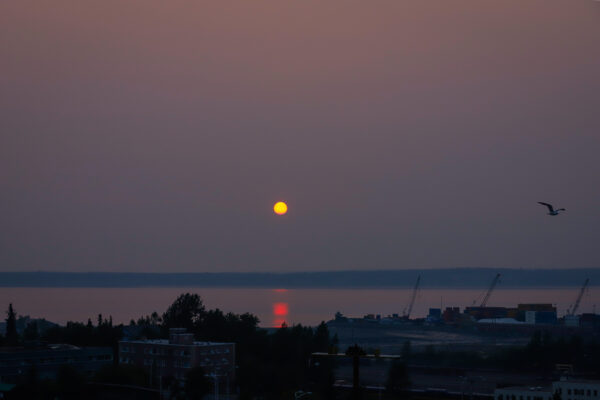
Smoke from dozens of wildfires in Western Alaska began spreading across the state over the weekend, covering the skies with a reddish tinge and leading to unhealthy air in some regions.
45 active wildfires in Western Alaska had burned more than a quarter million acres as of Sunday, according to the state Division of Forestry. They include the 150,000-acre East Fork Fire, one of just three fires in the area that are being manned.
Smoke from those fires reduced air quality from the Kenai Peninsula to the Seward Peninsula and the Brooks Range, with some of the worst particulate concentrations in Fairbanks as of Monday morning.
The concentration of smoke particles in the air in downtown Fairbanks was measured in the unhealthy range on Monday, according to the state Department of Environmental Conservation monitors.
That means people with asthma and children should avoid prolonged outdoor exertion.
RELATED: St. Mary’s residents pitch in to keep their village from burning
Smoke is expected to start clearing by Monday afternoon in Interior and Southcentral, said National Weather Service meteorologist Bobby Bianco.
But the shift in winds that’s clearing the smoke is also expected to bring warmer temperatures and lightning strikes to the Interior.
“There’s a danger of dry lightning starting new fires across the Interior,” said state fire spokesperson Sam Harrel.
Harrel said a lack of lightning in the Interior so far this season has resulted in fewer wildfires in the region, but over the weekend, crews did start work on two new human-caused blazes off the Steese Highway north of Fairbanks. Harrel said a fire investigator is looking into the source of both starts.
RELATED: Vulnerable residents flown out of St. Mary’s as major tundra fire closes in
In Southcentral, southerly winds are expected to start clearing smoke Monday evening as well. National Weather Service meteorologist Ray Christensen said that the improvement will be moderate at first.
“It won’t completely go away but I think you will see improvement over Southcentral over the next day or two,” he said.
As of Sunday 460,000 acres had burned statewide in Alaska, the 2nd highest amount at this point in the wildfire season, in the past 30 years.
Dan Bross is a reporter at KUAC in Fairbanks.
Lex Treinen is covering the state Legislature for Alaska Public Media. Reach him at ltreinen@gmail.com.





